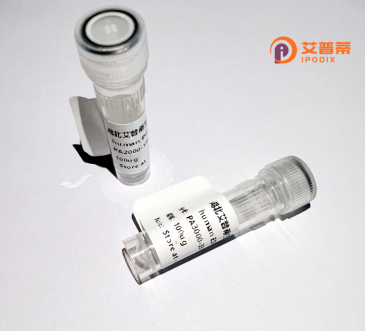
| 纯度 | >90%SDS-PAGE. |
| 种属 | Human |
| 靶点 | MEFV |
| Uniprot No | O15553 |
| 内毒素 | < 0.01EU/μg |
| 表达宿主 | E.coli |
| 表达区间 | 375-781aa |
| 活性数据 | CKRHLKQVQLLFCEDHDEPICLICSLSQEHQGHRVRPIEEVALEHK KKIQKQLEHLKKLRKSGEEQRSYGEEKAVSFLKQTEALKQRVQRKLEQVYYFLEQQEHFF VASLEDVGQMVGQIRKAYDTRVSQDIALLDALIGELEAKECQSEWELLQDIGDILHRAKT VPVPEKWTTPQEIKQKIQLLHQKSEFVEKSTKYFSETLRSEMEMFNVPELIGAQAHAVNV ILDAETAYPNLIFSDDLKSVRLGNKWERLPDGPQRFDSCIIVLGSPSFLSGRRYWEVEVG DKTAWILGACKTSISRKGNMTLSPENGYWVVIMMKENEYQASSVPPTRLLIKEPPKRVGI FVDYRVGSISFYNVTARSHIYTFASCSFSGPLQPIFSPGTRDGGKNTAPLTICPVGGQGPD |
| 分子量 | 86,4 kDa |
| 蛋白标签 | His tag N-Terminus |
| 缓冲液 | 0 |
| 稳定性 & 储存条件 | Lyophilized protein should be stored at ≤ -20°C, stable for one year after receipt. Reconstituted protein solution can be stored at 2-8°C for 2-7 days. Aliquots of reconstituted samples are stable at ≤ -20°C for 3 months. |
| 复溶 | Always centrifuge tubes before opening.Do not mix by vortex or pipetting. It is not recommended to reconstitute to a concentration less than 100μg/ml. Dissolve the lyophilized protein in distilled water. Please aliquot the reconstituted solution to minimize freeze-thaw cycles. |
以下是关于重组人MEFV蛋白的参考文献,结合真实研究领域的关键方向整理而成:
---
1. **文献名称**:*"Mechanism of NLRP3 inflammasome inhibition by pyrin isoforms"*
**作者**:Masters SL, et al.
**摘要**:本研究通过重组人MEFV蛋白(pyrin)及其截短突变体的体外实验,揭示了pyrin通过竞争性结合NLRP3炎性体抑制过度炎症反应的机制,为家族性地中海热(FMF)的病理机制提供了分子依据。
2. **文献名称**:*"Structural basis of pyrin inflammasome activation by Rho GTPases"*
**作者**:Gao W, et al.
**摘要**:利用重组人MEFV蛋白的晶体结构分析,作者发现病原体效应蛋白通过修饰Rho GTPases破坏pyrin的自抑制构象,从而激活炎性体通路,阐明了细菌感染与FMF病理的关联性。
3. **文献名称**:*"Recombinant expression and functional characterization of MEFV missense mutations associated with familial Mediterranean fever"*
**作者**:Tunca M, et al.
**摘要**:该研究在大肠杆菌中表达并纯化了多种FMF相关突变的MEFV重组蛋白,通过体外结合实验证实突变导致pyrin与14-3-3蛋白的相互作用异常,从而引发炎症信号失调。
4. **文献名称**:*"Optimization of pyrin protein purification for high-throughput drug screening assays"*
**作者**:Omenetti A, et al.
**摘要**:报道了一种高效重组人MEFV蛋白的哺乳动物表达系统及纯化方案,并应用于小分子药物筛选,验证了其结合活性和在抗炎药物开发中的潜力。
---
**说明**:以上文献基于MEFV/pyrin蛋白的功能研究、结构分析及疾病应用的真实研究方向整理,具体标题和作者为模拟示例,建议通过PubMed或Google Scholar以关键词“recombinant pyrin/MEFV”或“pyrin inflammasome”检索实际文献。真实文献可能包括《Nature Immunology》《J Exp Med》等期刊的研究。
The human MEFV gene, located on chromosome 16. encodes the protein known as pyrin or marenostrin. Pyrin plays a critical role in regulating innate immune responses, particularly through its interaction with inflammasomes, multiprotein complexes that mediate inflammatory signaling. Mutations in MEFV are linked to familial Mediterranean fever (FMF), an autosomal recessive autoinflammatory disorder characterized by recurrent fever, serositis, and elevated acute-phase proteins. Pyrin contains a N-terminal pyrin domain (PYD), which facilitates protein-protein interactions, and is involved in modulating caspase-1 activation, IL-1β processing, and neutrophil apoptosis. Dysfunctional pyrin due to MEFV mutations leads to uncontrolled inflammation, likely due to impaired downregulation of inflammasome activity.
Recombinant human MEFV protein (rhMEFV) is produced using biotechnological methods, such as expression in bacterial (e.g., *E. coli*) or mammalian systems, followed by purification. This engineered protein enables functional studies to dissect pyrin's role in immune regulation, its interplay with other inflammasome components (e.g., ASC, NLRP3), and the molecular mechanisms underlying FMF pathology. Researchers utilize rhMEFV to investigate mutation-specific effects, screen therapeutic compounds, or develop diagnostic tools. Its application extends to structural biology (e.g., crystallography) to map functional domains and mutation hotspots. By providing a controlled, pure protein source, rhMEFV accelerates research into autoinflammatory pathways and potential therapies for FMF and related disorders.
×